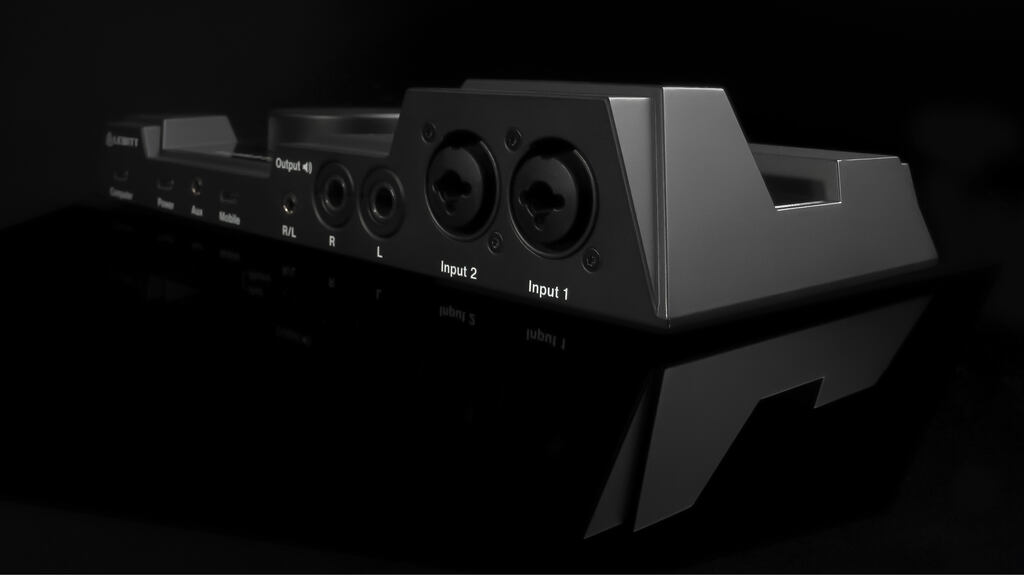
Blog
True love for great sound unites us.
Blog
True love for great sound unites us.
Do you want to record a podcast, live stream, produce, or record some music? All of these activities use an audio interface. If you don't yet know what this is; don't worry.
In this blog, we will teach you about audio interfaces. You will get a detailed description of what they do and how they can make your creative work easier. Let's dive in!
From the external gear to the computer, audio must be converted from analog to digital through ADC (Analog-to-Digital conversion).
From your computer to external gear, the audio must be converted back from digital to analog through DAC (Digital-to-Analog conversion).
At its core, an audio interface is a bridge between a computer and external analog audio gear.
An audio interface can transform electric signals from external gear, like a microphone, into data stored on a computer. It is also capable of transforming data from a computer into electric signals to produce sound on speakers or headphones.
When you record audio in a recording software, ADC happens. And when you play the recorded file back, DAC makes the signal audible.
Depending on the connections of an audio interface, you can connect various devices.
For example:

A USB microphone, laptop microphone, or laptop speakers will use a built-in audio interface. These integrated audio interfaces are reduced to core functions.
When we talk about an audio interface in the pro audio world, we talk about devices that capture and reproduce audio most accurately. And, of course, offer functionalities beyond the basics of AD and DA conversion.
So, whether you need an audio interface depends on what you want to do.
A pro audio interface converts analog to digital signals and vice-versa very accurately.
Suppose you want to record music, a podcast, or a live stream, and you are not happy with the audio quality of your laptop or headset. In that case, an audio interface and a microphone are the logical next steps.

When deciding what interface is correct for you, the first thing you should ask yourself is how many inputs and outputs you need.
Suppose you want to record a complete drum kit or a band that needs headphone monitoring. In that case, your requirements will be very different from those of a singer who wants to record vocals and occasionally some guitar.
Once you have established how many inputs and outputs you need, you will have various options. They will be different in terms of price, features, looks, and more.
Requirements are also different for different applications. For live streaming, you might need loopback capability more than anything else.
To further determine the quality of interfaces, a manufacturer usually specifies its properties.
Some defining factors you should look for are transparent frequency responses, high dynamic range, low total harmonic distortion, low self-noise, low latency, possible sample rates, and other features.
Check out the CONNECT 6, an audio interface for modern musicians and creators with game-changing flexibility.

Over the years, audio interfaces have been expanding from the basic core functionality. They often implement handy new features to make your life easier. A few audio interfaces, like the CONNECT 6, also enable new workflows and more elaborated functionalities.
Let's take a closer look at some of them.
All audio interfaces that offer recording functions have built-in preamps with adjustable gain. You can adjust the input signal to the correct signal level.
If you want to learn more about preamps, check out the blog “What is a preamp”.
Condenser microphones need 48V phantom power to generate an audio signal. The audio interface provides the required voltage through the XLR connection.
To connect an electric guitar or bass directly to your audio interface, an input with high impedance is the best. Instrument inputs make sure that your input signal is as clean and optimized as possible.
Another common feature is a low-cut filter. This option allows you to filter out low-frequency rumble from your input signal.
Learn more about this topic on the blog “What does a low-cut filter do?”
Now, let's look at some more advanced features.
Higher-grade audio interfaces, like the CONNECT 6, offer powerful DSP features that enhance the incoming audio signal in real-time.
Such DSP effects range from equalization, compression, and reverb to delay.
Some interfaces, like CONNECT 6, have multiple USB connections. This lets you connect a 2nd device, like a phone, tablet, or PC, directly into your audio setup. This can come in handy if you want to stream to Instagram or TikTok but use your full audio setup.
On an even higher level, an audio interface could integrate fully-fledged VSTs or VST-like applications and run them natively on the interface. This helps your computer save computing power and makes your DAW run faster.
For some audio interfaces, complementary software can handle complex workflows, provide more and easier options, and enhance the user experience.
For example, you can adjust features, store presets, and change options more precisely. A good example is the CONTROL CENTER software for CONNECT 6.
MIDI is a communication protocol that allows audio gear and instruments to communicate. It does not carry audio signals but data related to musical events and parameters. Some audio interfaces offer MIDI ports so that you can send control signals to your synths directly from your DAW, for example.
You can learn more about MIDI on Wikipedia.
We hope this article cleared up some questions you might have about audio interfaces. If you still have questions, don't hesitate to reach out on social media or through email. We are happy to help.
LEWITT audio interfaces